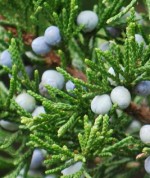
Eastern red cedar is an evergreen coniferous tree and a member of the cypress family, Cupressaceae, that also includes arborvitae and junipers ,and is not a true cedar. It is native to the woodland edges, old fields, meadows, pastures, fence rows, and rocky ground of eastern North America from Nova Scotia and Ontario, south to Florida and Texas. Plants prefer sunny sites moist soil but tolerate poor dry soil. They cause hay fever in some people and are a host for cedar-apple rust, a fungal disease that badly damages apple crops but does no damage to eastern red cedar.
Description: Eastern red cedar is a small to medium sized tree with a conical or oval to rounded form and has reddish brown bark that is scented and exfoliates in thin ragged strips. The awl-like needles are olive to deep green, darkening or yellowing in winter. Male and female cones are produced on separate trees. The berry-like female cones are blue-gray with a white wax covering, and up to ¼ inch long while the male pollen cones are half that size. The seed cones are attractive to many birds and are used to flavor gin. Plants spread by seed.
Control: Pull, mow or cut seedlings as they appear. Chop down larger plants; they usually do not resprout. Herbicides are not usually effective.